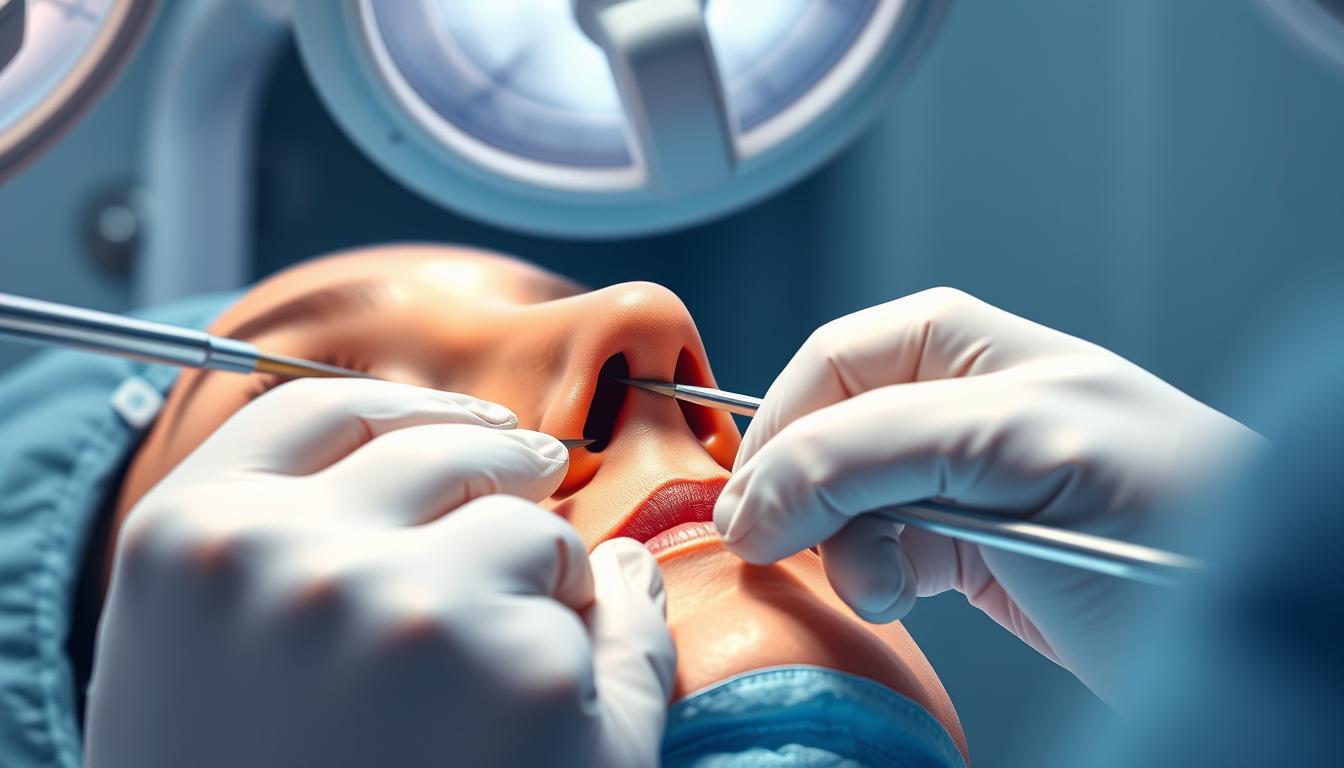Tip rhinoplasty, a specialized form of nose surgery, has gained popularity for its ability to refine and reshape the nasal tip, enhancing facial harmony and overall appearance. This procedure is sought after by individuals looking to address specific concerns such as bulbous or droopy tips without undergoing a full rhinoplasty.
As a less invasive alternative to traditional surgery on the nose, tip rhinoplasty offers potentially shorter recovery times, making it an attractive option for those seeking to improve their nasal tip’s shape and functionality. Understanding the procedures, expected results, and recovery process is crucial for individuals considering this surgery.
Key Takeaways
- Tip rhinoplasty is a specialized form of nose surgery focusing on the nasal tip.
- It enhances facial harmony and overall appearance.
- This procedure is less invasive with potentially shorter recovery times.
- Understanding the procedure and expected results is crucial.
- Choosing the right surgeon is vital for successful outcomes.
Understanding Tip Rhinoplasty
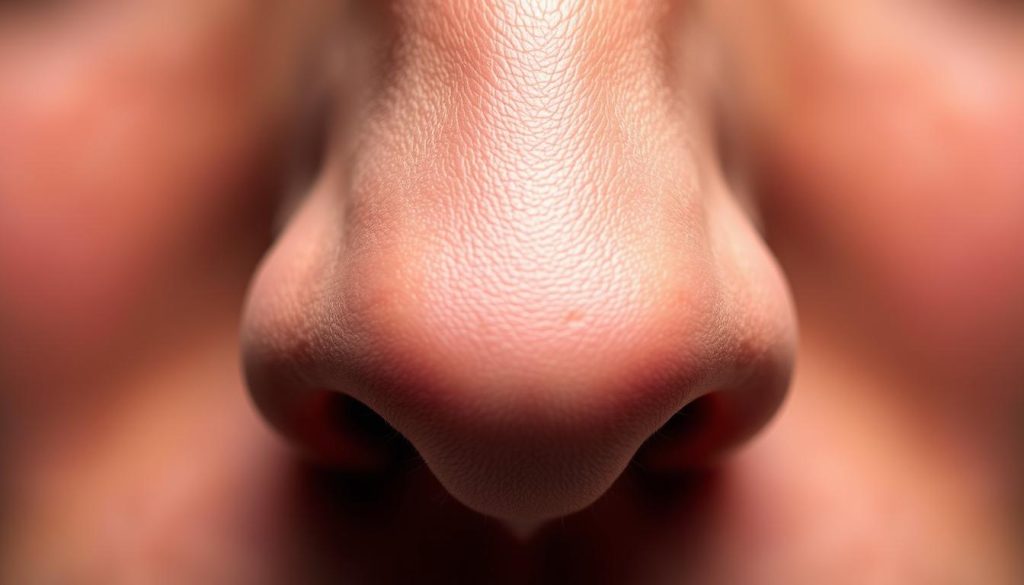
The nasal tip is a critical aspect of the nose’s overall aesthetic, and tip rhinoplasty addresses this with precision. Tip rhinoplasty is a surgical procedure that focuses on reshaping the tip of the nose.
Definition and Purpose
Tip rhinoplasty is defined as a surgical intervention aimed at refining the shape, size, and orientation of the nasal tip. The primary purpose of this surgery is to enhance the aesthetic appeal of the nose by making subtle yet significant changes to the nasal tip, thereby improving the overall facial harmony.
Difference Between Tip Rhinoplasty and Full Rhinoplasty
Tip rhinoplasty differs from full rhinoplasty in its focus and scope. While full rhinoplasty involves comprehensive changes to the entire nose structure, including the bridge, tip rhinoplasty is a more targeted procedure that exclusively addresses the nasal tip. This distinction results in differences in surgical approaches, recovery periods, and the techniques employed.
The key differences between tip rhinoplasty and full rhinoplasty include:
- Surgical approach: Tip rhinoplasty is often less invasive.
- Recovery period: Tip rhinoplasty may offer a shorter and less uncomfortable recovery.
- Technique: Tip rhinoplasty involves cartilage reshaping, unlike full rhinoplasty which may involve bone restructuring.
Common Nose Tip Concerns and Solutions
The tip of the nose is a critical aspect of nasal aesthetics, and various concerns can prompt individuals to seek surgical correction. Common issues include a bulbous tip, droopy or overly long tip, and an upturned or contracted nose, each requiring distinct surgical approaches.
Bulbous Tip Correction
A bulbous nose tip can make the nose appear larger and less defined. Correction involves reshaping the nasal cartilage to create a more refined tip. This is typically achieved through a combination of cartilage removal and suturing techniques.
Droopy or Long Tip Refinement
A droopy or long nasal tip can give the nose an aged or unbalanced appearance. Surgical refinement involves shortening the nasal tip and reorienting the nostrils for a more youthful look. This may include adjusting the cartilage and repositioning the tip.
Upturned (Contracted) Nose Correction
An upturned or contracted nose is characterized by an excessively rotated nasal tip, often exposing too much of the nostrils. This condition can result from adverse reactions to implants, scar tissue formation, or natural anatomy. Correction involves lengthening the nose and adjusting the columella to reduce nostril visibility. Cartilage grafts are commonly used to provide structural support and achieve a more balanced appearance.
| Nasal Tip Concern | Surgical Correction |
|---|---|
| Bulbous Tip | Reshaping nasal cartilage |
| Droopy/Long Tip | Shortening and reorienting the tip |
| Upturned/Contracted Nose | Lengthening the nose and adjusting columella |
According to a renowned plastic surgeon, “The key to successful nose tip correction lies in understanding the individual’s nasal anatomy and applying the appropriate surgical technique to achieve a harmonious and natural result.”
“The goal of tip rhinoplasty is not just to alter the tip but to ensure it is in proportion with the rest of the nose and face.”
Why Korea Excels in Tip Rhinoplasty
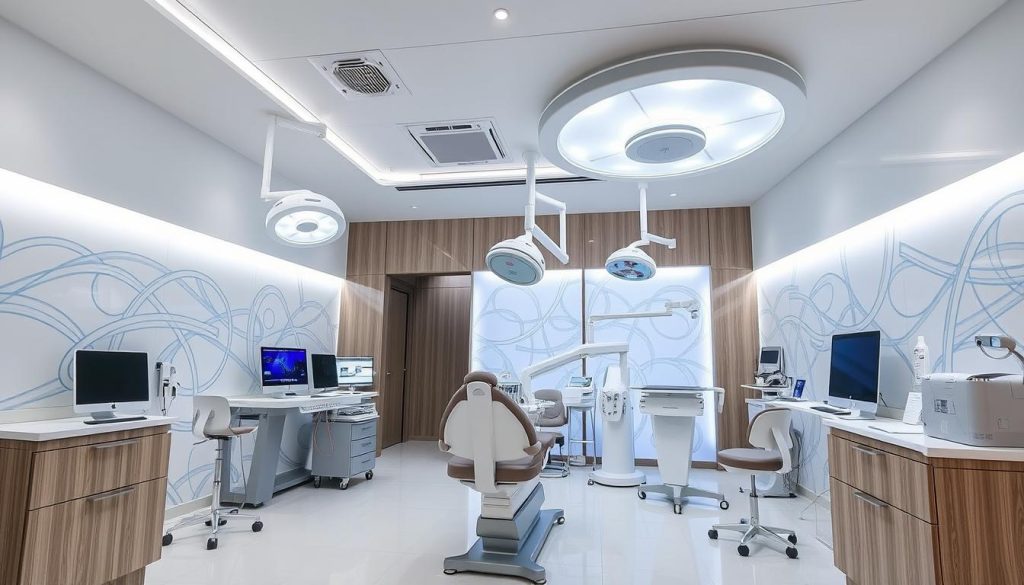
Korea has become a hub for tip rhinoplasty, attracting patients worldwide with its advanced techniques and competitive pricing. The country offers a unique combination of high-quality medical services and affordability, making it an attractive destination for medical tourists.
Advanced Techniques and Technology
Korean surgeons employ the latest techniques and technologies in tip rhinoplasty, ensuring precise and effective results. The use of advanced equipment and innovative methods allows for a more personalized approach to each patient’s needs.
Expertise and Training of Korean Surgeons
The expertise of Korean surgeons is a significant factor in the country’s success in tip rhinoplasty. These professionals undergo rigorous training and have extensive experience in performing complex rhinoplasty procedures, ensuring high-quality outcomes.
Cost-Effectiveness Compared to Western Countries
The cost of tip rhinoplasty in Korea is significantly lower compared to Western countries, particularly the United States. While the price in Korea ranges from $600 to $6,100, it starts at $8,075 in the USA. This substantial cost savings, combined with the high quality of care, makes Korea an appealing choice for those seeking tip rhinoplasty.
The competitive medical market in Korea drives innovation and maintains competitive pricing, further enhancing the country’s appeal to medical tourists. Comprehensive care packages that include accommodations, transportation, and follow-up care add to the overall cost-effectiveness of undergoing tip rhinoplasty in Korea.
Pre-Surgery Consultation Process
The pre-surgery consultation process is a crucial step in achieving the desired outcome for tip rhinoplasty. This process allows patients to understand the procedure and what to expect during and after surgery.
Important Questions to Ask Your Surgeon
During the consultations, patients should ask their surgeon several important questions to ensure they are well-informed. These include inquiries about the surgeon’s experience with tip rhinoplasty, the techniques used, and the expected results. Patients should also discuss their expectations regarding the shape and appearance of their nose after surgery.
3D Imaging and Planning Your Results
Advanced 3D imaging technology has revolutionized the pre-surgical planning process for tip rhinoplasty in Korean clinics. By getting a 3D CT scan on their first visit, patients can visualize their custom nose shapes. This technology enables surgeons to create a digital simulation of the patient’s nose, allowing for adjustments to be made to demonstrate various possible outcomes. Patients can actively participate in designing their results, providing feedback until they are satisfied with the design.
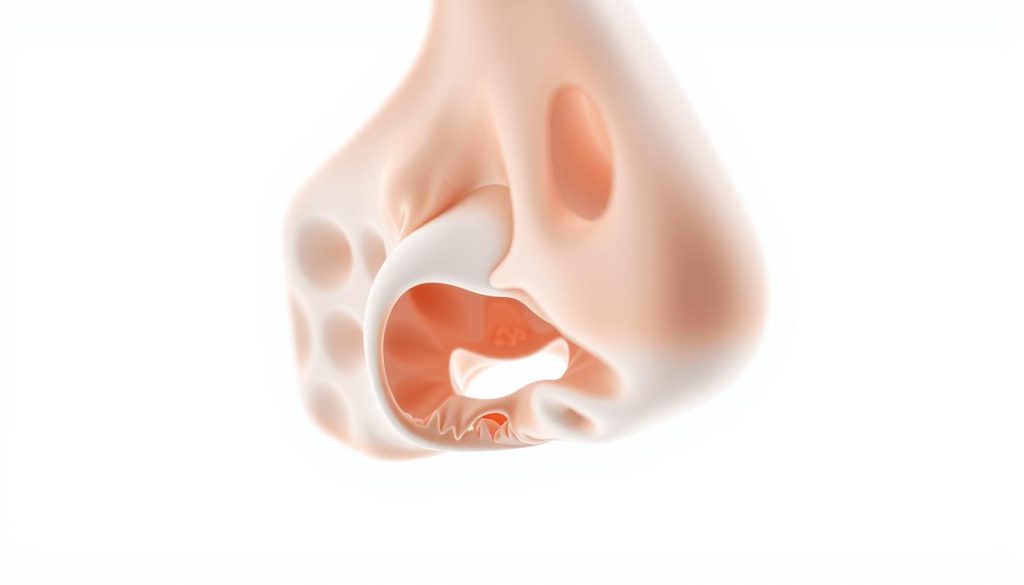
Korean Tip Rhinoplasty Techniques
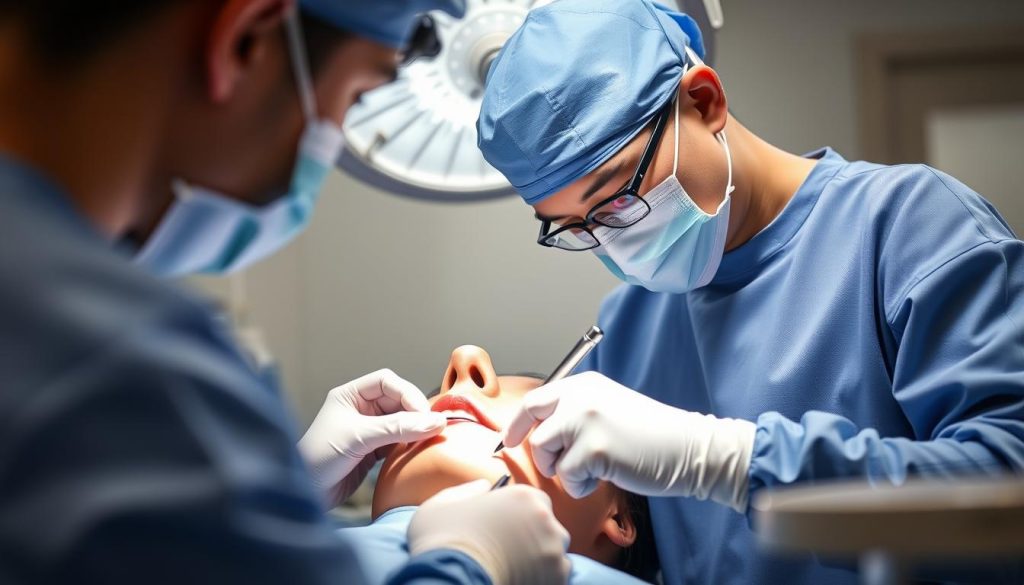
Korean surgeons are renowned for their innovative approaches to tip rhinoplasty. The techniques employed in Korea for nasal tip refinement are diverse, reflecting the country’s position at the forefront of rhinoplasty advancements.
Open vs. Closed Approach for Tip Surgery
The choice between an open and closed approach for tip rhinoplasty depends on the complexity of the procedure and the patient’s nasal structure. An open approach provides greater visibility and access to the nasal tip, allowing for more intricate modifications. In contrast, a closed approach is less invasive, resulting in no visible scarring and potentially quicker recovery.
Cartilage Grafting Methods
Cartilage grafting is a critical technique in tip rhinoplasty, used to enhance the shape and projection of the nasal tip. Korean surgeons often utilize autologous cartilage grafts, which are taken from the patient’s own body, to achieve natural-looking results. The use of advanced imaging technologies aids in precise planning and execution of these grafting procedures.
Non-Surgical Alternatives
For patients seeking minor adjustments, liquid rhinoplasty using dermal fillers offers a non-surgical alternative. This approach allows for temporary modifications to the nasal tip, enabling patients to “test drive” changes without committing to surgery. While limited in their application, non-surgical treatments can be effective for subtle enhancements and camouflaging minor irregularities.
The variety of procedures and treatments available in Korea caters to a wide range of patient needs, from subtle refinements to more significant restructuring. The results of these rhinoplasty techniques are often characterized by their natural appearance and the minimal nose trauma involved.
The Procedure: Step by Step
The surgical process for tip rhinoplasty in Korea is detailed and involves several important stages. Patients undergo a comprehensive procedure that is tailored to their specific needs and desired outcomes.
Anesthesia Options
Before the surgery begins, patients are administered anesthesia to ensure comfort during the procedure. Korean clinics typically offer both local and general anesthesia options, depending on the complexity of the case and patient preference.
Surgical Process
The surgical process involves precise techniques to reshape the nose tip. Surgeons may use either an open or closed approach, depending on the required modifications. The use of advanced technology and grafting methods is common to achieve the desired results.
Duration and Immediate Post-Op Care
The duration of the procedure can range from 1 to 4 hours, depending on the complexity. After the surgery, patients are closely monitored in a recovery area until the effects of anesthesia subside. They receive specific instructions for the first 24-48 hours, including applying cold compresses, keeping the head elevated, and taking prescribed medications for pain management and infection prevention.
To facilitate a smooth recovery, patients are advised to apply an ice pack for 4 days post-rhinoplasty and use high-level pillows for 5 days when sleeping. Avoiding intense activities or exercises for 8 weeks after the surgery is also recommended.
| Post-Op Care Instructions | Duration |
|---|---|
| Apply Ice Pack | 4 days |
| Use High-Level Pillows | 5 days |
| Avoid Intense Activities | 8 weeks |
Following these care instructions meticulously is crucial for optimal healing and results. Korean clinics often provide specialized post-operative care packages, including daily check-ups and professional cleaning of the surgical site.
Materials Used in Nose in Korea
Korean surgeons often prefer using autologous tissues for rhinoplasty due to their natural compatibility and reduced risk of complications. This approach is particularly beneficial for patients undergoing revision rhinoplasty, who have previously experienced difficulties with foreign implants.
Silicone Implants vs. Autologous Tissues
The debate between using silicone implants and autologous tissues in rhinoplasty is significant. Silicone implants are synthetic materials that can be associated with higher risks of rejection and complications. In contrast, autologous tissues, taken from the patient’s own body, offer a more natural and safer alternative. Using the patient’s own tissues reduces the risk of foreign body reactions and can lead to more sustainable results.
Rib and Ear Cartilage Harvesting
Korean surgeons have mastered the techniques of harvesting cartilage from the rib and ear for use in rhinoplasty. Rib cartilage is particularly useful for significant reconstructions due to its abundance and strength. However, it may warp over time. Ear cartilage, on the other hand, is more flexible and ideal for delicate tip refinements.
| Cartilage Source | Characteristics | Best Use |
|---|---|---|
| Rib Cartilage | Strong, abundant, may warp | Major structural changes |
| Ear Cartilage | Flexible, less abundant | Minor tip refinements |
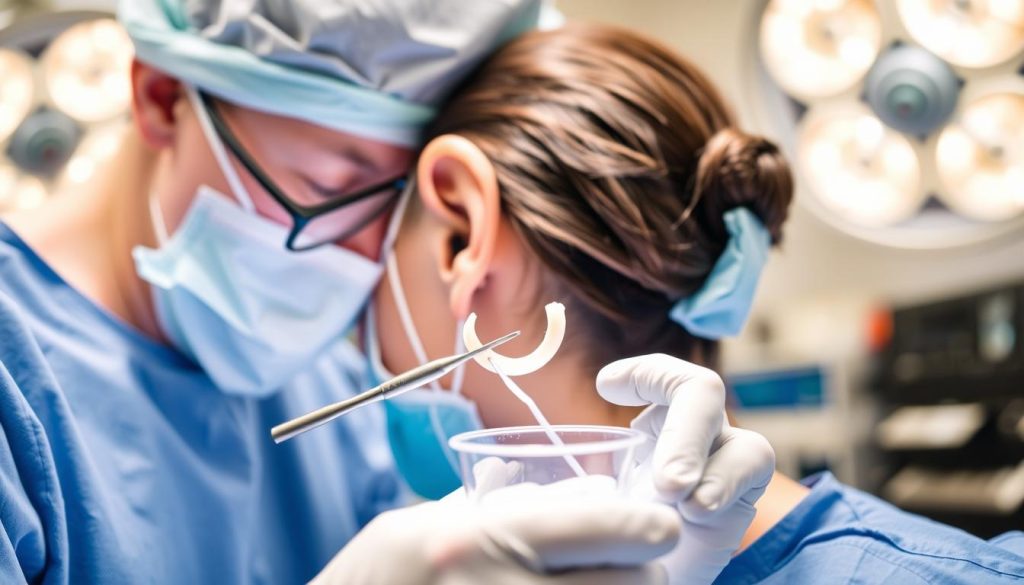
The choice between rib and ear cartilage depends on the extent of reconstruction needed. Advanced techniques like ear composite grafting, where tissue and skin are harvested along with cartilage, are used for complex revision cases.
Recovery Timeline After Tip Rhinoplasty
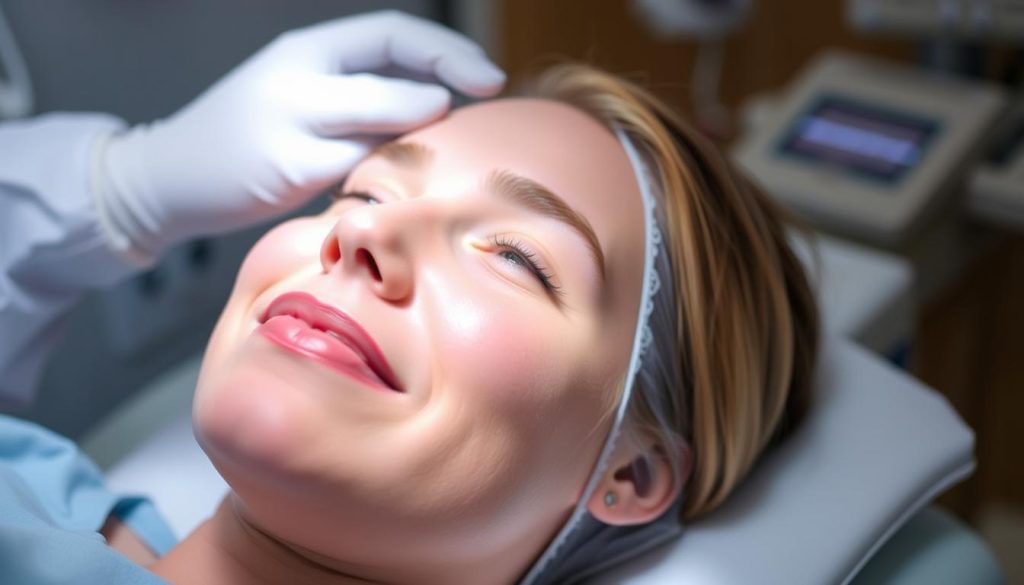
Knowing what to expect during the recovery period can help patients prepare for tip rhinoplasty surgery. The recovery timeline varies among individuals, but understanding the general stages can help manage expectations.
First 48 Hours
The initial 48 hours post-surgery are critical. Patients typically experience swelling and bruising, which can be managed with cold compresses and prescribed medication. Rest is essential during this period to facilitate healing.
First Week Post-Surgery
During the first week, patients are advised to avoid strenuous activities. The stitches are usually removed on the 5th or 7th day. Dr. Lee monitors the patient’s condition closely to ensure a smooth recovery.
Weeks 2-4: Returning to Normal Activities
By the second week, most patients can resume their normal activities, although some swelling may still be present. It’s essential to follow the surgeon’s instructions regarding physical activity and post-operative care to avoid complications.
Complete Healing: What to Expect Long-Term
The complete resolution of swelling, especially around the nasal tip, can take up to a year or longer. Factors such as seasonal changes, salt intake, and hormonal fluctuations can temporarily affect swelling. Patience is crucial as the final aesthetic outcome gradually emerges.
Surgeons typically schedule follow-up appointments at 3 months, 6 months, and 1 year to monitor progress. The final result should appear natural and harmonious with other facial features, with the surgical intervention becoming increasingly undetectable as complete healing occurs.
Managing Post-Operative Care
Proper post-operative care is crucial for a smooth recovery after tip rhinoplasty. Patients must follow specific guidelines to ensure optimal healing and results.
Controlling Swelling and Bruising
To minimize swelling and bruising, patients are advised to apply an ice pack for 4 days after the surgery. Elevating the head while sleeping using high-level pillows for 5 days can also help reduce swelling. Avoiding intense activities or exercises for 8 weeks post-surgery is crucial for a complication-free recovery.
When to Contact Your Surgeon
It’s essential for patients to know when to seek medical attention. Scenarios that warrant immediate contact with the surgical team include:
- Excessive bleeding beyond light spotting
- Severe pain unrelieved by prescribed medication
- Signs of infection such as increasing redness, warmth, or purulent discharge
- Significant asymmetry, sudden changes in the shape of the nose, or difficulty breathing
- Fever above 101°F (38.3°C), persistent nausea or vomiting, or unusual swelling extending to the eyes or cheeks
Maintaining all scheduled follow-up appointments is vital, even if recovery seems to be progressing well. Many Korean clinics offer telemedicine options for post-return consultations, ensuring continuity of care even after leaving the country.
| Post-Operative Care Instructions | Duration |
|---|---|
| Apply ice pack | 4 days |
| Use high-level pillows | 5 days |
| Avoid intense activities | 8 weeks |
Cost Breakdown of Tip Rhinoplasty in Korea
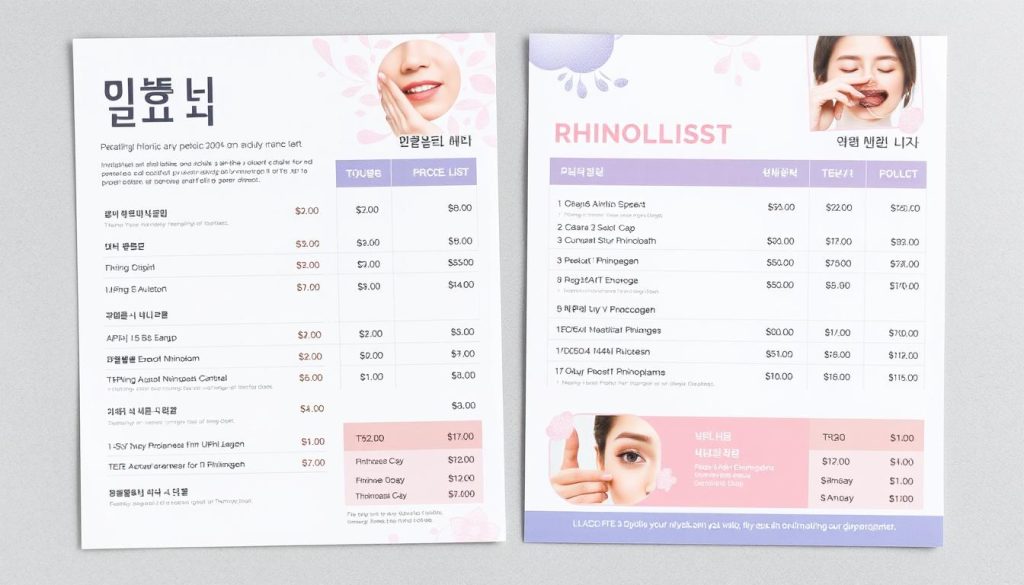
Understanding the cost breakdown of tip rhinoplasty in Korea is crucial for patients planning to undergo this surgery. The total cost encompasses various elements, including the surgical technique, materials used, and the clinic’s facilities.
Price Range for Different Techniques
The cost of tip rhinoplasty in Korea varies significantly depending on the technique used. Techniques such as open or closed rhinoplasty, and the use of cartilage grafting, can influence the overall cost. On average, prices can range from $2,000 to $5,000.
What’s Included in Medical Tourism Packages
Many clinics in Korea offer medical tourism packages that include a range of services beyond the surgical procedure. These packages often cover hotel accommodation, airport transfers, bilingual translation services, hospitalization, medication, pre-op consultations, and post-op care such as Hyperbaric Oxygen Therapy.
Additional Expenses to Consider
While medical tourism packages cover a significant portion of the costs, patients should be aware of additional expenses. These can include international travel costs, extended accommodation if needed, additional treatments or procedures, incidental expenses like meals and entertainment, and potential follow-up care in their home country.
It’s essential for patients to factor these costs into their budget to ensure a smooth and stress-free experience. By understanding the total cost involved, patients can make informed decisions about their tip rhinoplasty in Korea.
Top Clinics for Tip Rhinoplasty in Korea
For those seeking the best tip rhinoplasty in Korea, several top-tier clinics stand out. These clinics have garnered international recognition for their exceptional services and results.
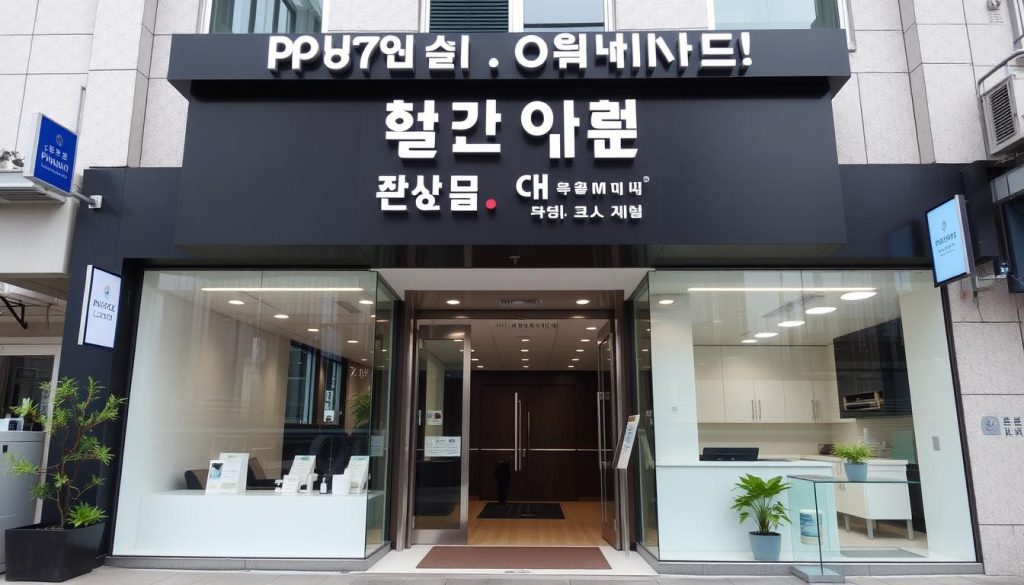
THEPLUS Plastic Surgery
THEPLUS Plastic Surgery is a prominent name in the realm of tip rhinoplasty. Their expert team is led by highly experienced surgeons who specialize in personalized rhinoplasty procedures. They offer a range of techniques, including nose tip refinement and projection enhancement.
Made Young Plastic Surgery
Made Young Plastic Surgery is another leading clinic that has gained a reputation for its comprehensive rhinoplasty services. Their team is dedicated to providing patients with natural-looking results that enhance their unique beauty.
Okay Plastic Surgery Clinic
Okay Plastic Surgery Clinic is a leading destination for those seeking transformative aesthetic care in Korea. With a philosophy centered on sincerity, precision, and individualized treatment, the clinic ensures that each patient receives a tailored solution. Led by a team of specialized professionals, including a renowned female plastic surgeon, Okay Plastic Surgery Clinic offers a comprehensive journey of personal transformation through expertise, empathy, and cutting-edge medical techniques.
Planning Your Medical Trip to Korea
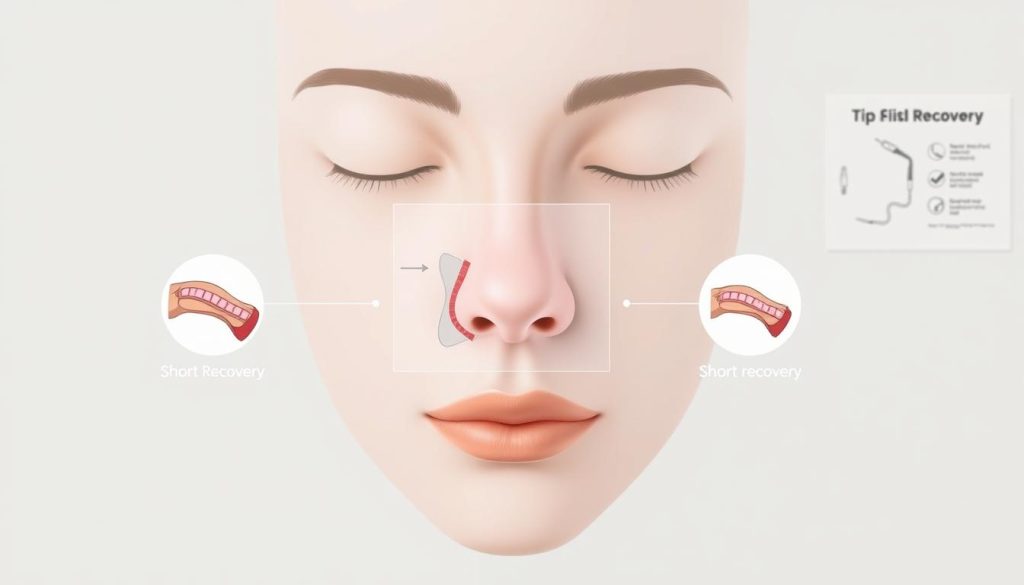
As a popular destination for medical tourists, Korea offers a comprehensive infrastructure for patients undergoing tip rhinoplasty. The country’s advanced clinics and experienced surgeons make it an ideal location for those seeking high-quality nose surgery.
Visa Requirements and Stay Duration
Before traveling to Korea for tip rhinoplasty, patients must understand the visa requirements and potential stay duration. Depending on their nationality, patients may need to apply for a specific visa, such as a medical visa, which allows them to stay in Korea for the required treatment period.
Accommodation Options Near Major Clinics
Korea’s major clinics often have nearby accommodation options, ranging from budget-friendly hotels to luxury resorts. Many clinics also offer assistance in booking accommodations, making it easier for international patients to plan their stay. Some clinics have partnerships with local hotels, providing patients with discounted rates.
Translation Services and Communication
Top clinics in Korea employ dedicated bilingual coordinators who facilitate communication between international patients and medical staff throughout the entire process. These coordinators assist with translation during consultations, ensuring that patients can accurately express their desires and understand the surgeon’s recommendations. Additionally, some clinics utilize technological solutions like translation apps to supplement in-person translation services.
Potential Risks and How to Minimize Them
Understanding the potential risks associated with tip rhinoplasty is essential for making an informed decision. While the procedure can significantly enhance the appearance of the nose, it’s crucial to be aware of the possible complications.
Common Side Effects
Common side effects of tip rhinoplasty include swelling, bruising, and temporary numbness around the nose. These effects are typically short-lived and resolve on their own within a few weeks. Patients can minimize these effects by following their surgeon’s post-operative instructions carefully.
Serious Complications to Be Aware Of
Although rare, serious complications can occur, including infection, bleeding, or adverse reactions to anesthesia. Choosing a skilled surgeon with expertise in rhinoplasty can significantly reduce the risk of these complications.
Choosing a Surgeon with Revision Experience
Selecting a surgeon with experience in revision rhinoplasty is crucial, even for primary tip procedures. Such surgeons possess advanced skills in handling complex nasal anatomy and are better equipped to prevent complications. When evaluating a surgeon’s credentials, look for before-and-after photos of their revision cases and inquire about their approach to complicated cases.
By choosing a surgeon with the right expertise and following their guidance, patients can minimize the risks associated with tip rhinoplasty and achieve a successful outcome.
Is Tip Rhinoplasty in Korea Right for You?
When considering tip rhinoplasty, it’s crucial to understand the nuances of nasal surgery and its impact on overall facial harmony. The goal of tip rhinoplasty is not just to alter the nose, but to enhance the individual’s natural beauty and facial balance.
Ideal candidates for tip rhinoplasty are those with specific concerns about the nasal tip, such as bulbousness, droopiness, lack of definition, or asymmetry. Korea offers a unique advantage with its specialized expertise in Asian and ethnic rhinoplasty, advanced procedures, and competitive pricing.
Before making a decision, it’s essential to have realistic expectations about what tip rhinoplasty can achieve. Patients should research thoroughly and consult with multiple surgeons to evaluate their credentials, experience, and reputation. The decision to undergo tip rhinoplasty should be made for personal satisfaction, not to meet others’ expectations or current beauty trends.
Ultimately, tip rhinoplasty in Korea can be a viable option for those seeking to enhance their appearance and confidence. By understanding the procedures, treatments, and what to expect, individuals can make an informed decision that aligns with their needs and goals, potentially achieving high-quality results from a reputable clinic.
FAQ
What is the difference between tip rhinoplasty and full rhinoplasty?
Tip rhinoplasty focuses on reshaping the tip of the nose, whereas full rhinoplasty involves restructuring the entire nose, including the bridge and nostrils. Tip rhinoplasty is a more targeted procedure, often used to refine the nasal tip’s shape, size, or orientation.
How long does it take to recover from tip rhinoplasty?
The recovery time varies, but most patients can return to their normal activities within 1-2 weeks. However, it may take several months for the nose to fully settle and for the final results to be visible.
What are the benefits of choosing a Korean surgeon for tip rhinoplasty?
Korean surgeons are renowned for their expertise in rhinoplasty, particularly in tip refinement. They often employ advanced techniques and technologies, such as 3D imaging, to achieve precise and natural-looking results.
Are there any non-surgical alternatives to tip rhinoplasty?
Yes, non-surgical alternatives, such as injectable fillers, can be used to temporarily enhance the nasal tip’s appearance. However, these methods are not a substitute for surgical rhinoplasty and may require repeated treatments to maintain the desired effect.
How much does tip rhinoplasty cost in Korea?
The cost of tip rhinoplasty in Korea varies depending on the technique, surgeon’s fees, and clinic facilities. On average, the price range is competitive compared to Western countries, with some clinics offering package deals that include accommodation and translation services.
What are the potential risks and complications associated with tip rhinoplasty?
As with any surgical procedure, tip rhinoplasty carries risks, such as infection, scarring, and asymmetry. However, these risks can be minimized by choosing a qualified and experienced surgeon who has a proven track record in revision rhinoplasty.
Can I undergo tip rhinoplasty if I have had previous nose surgery?
Yes, but it’s essential to consult with a surgeon who has experience in revision rhinoplasty. They will assess your nasal structure and determine the best approach to achieve your desired outcome.
How do I choose the right clinic and surgeon for my tip rhinoplasty?
Research clinics and surgeons thoroughly, looking for credentials, patient reviews, and before-and-after photos. It’s also crucial to schedule a consultation to discuss your goals and assess the surgeon’s communication style and expertise.
